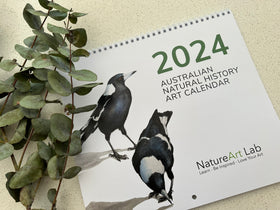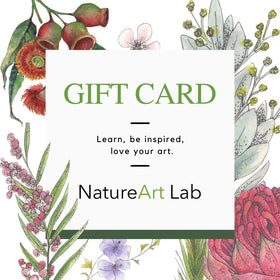
A Bettong Workshop? ....... No Way! - By Peter Trusler
Wonderful things can grow from the seeds of crazy ideas.
I found myself standing at the gates of Mulligans Flat Nature Conservation Reserve in the descending dusk last Thursday evening (19 March 2019). The scene eerily resembled the perimeter of a detention centre and I was somewhat trepidatious about what was confined within. There was a little quiet introductory conversation punctuating the balmy night air, for I had only just met 12 other artists for the first time and a biology PhD researcher had volunteered to guide us for the evening. I had no idea how the night would unfold and yet, I was to conduct an art workshop with the group for the next three days on the basis of what we were about to experience.
This all started on the premise of combining art practices, conservation biology and tuition in one workshop. Yes, Okay? But, That premise unfolded as follows…….We were to be dealing with small nocturnal marsupials. Great! They’re going to be shy, fast and in the dark. That just about rules out visual art. Oh! It’s quite an opportunity because they are almost extinct. Great! That raises more cultural and scientific questions than most would still dare to ask. And one other thing! It would be interesting to broaden the usual natural history illustrative genre and indulge creative oil painting practices. Some of the group would be very experienced in this respect and perhaps others would be trying the medium the first time. Uh Huh! Well, that means covering ‘the basics’ right through to ‘master-class’ level. And……Believe it or not, I was familiar with the phrase “Never work with animals, children ,…..or artists!”
Aside from these issues, I had never laid eyes on the subject of interest before, the Eastern Bettong, Bettongia gaimardi. I nearly declined the invitation, but during that conversation with Julia Landford (Founding Director NatureArt Lab), I realised that such a workshop was really worth doing for all of these very problematic reasons. Sure, it was going to be an enormous challenge for everyone, and yet the science and the culture it would embrace and promote is so critically important for the future. That much, I understood. Her enthusiasm seemed well founded.
The gates were unlocked and off we set; red-light torches in hand, notebooks and pencils in pockets, a camera or binoculars slung over some shoulders and earphones tuned to our guide’s commentary.
The Bettongs soon appeared among their larger kangaroo and wallaby cousins. At times they were just fleeting glimpses of the little creatures as they ricocheted into the dark before us. On other occasions, they propped and allowed our group to approach to within 6 metres or so. We saw some youngsters too. All the while, we were learning about the amazing research-based conservation efforts that were being made at Mulligans. We were experiencing first hand how the wildlife, (possums, gliders, micro bats, night birds, quoll, macropods and rodents), performed their roles in rehabilitating the open woodland in the reserve. Sadly, this pocket of habitat represented a formerly widespread ecosystem that is in seriously rapid decline. The parched starkness of the pale grey timber and foliage illuminated by torchlight only served to heighten the ghostliness about that which was vanishing. It always requires such an intense endeavour to re-establish what can be so blithely destroyed in ignorance. Trying not to crunch the leaf-litter too loudly as we walked only served to remind me of how clumsy humanity is when faced with such truths. It was high time to focus our powerful hearts and minds!
We learned too of the specific ecological role that the bettongs performed in a natural system. By feeding almost exclusively on native truffles, these little ‘rat-kangaroo’ gourmets were in fact soil engineers and were largely responsible for ensuring the nutrient and plant regeneration cycles on the forest floor. Bettongs worked in partnership with mycorrhizal soil fungi. We then became aware that their little truffle excavation pits were dotted all about us. So, such endearing marsupials, at least to our naïve human eyes, were capable of doing things so profound and in highly beneficial ways! Of the six species of Bettongs distributed across mainland Australia, all now have dramatically reduced, isolated populations confined mostly to small reserves and refuge islands. One of these, the Desert Rat-kangaroo is already extinct. The Bettongs at Mulligans were just one species among several being deployed in a handful of projects around the country with the ultimate aim of reintroducing endangered marsupials back to mainland Australia. It is a heartbreaking scramble to learn about the lives of these highly endangered animals in order to ensure their survival and the health of the ecosystems to which they belong. Why are they are so vulnerable to the introduced animals that ‘society’ knows and loves more dearly? Where do my value systems lay?
All is very precarious, but none immediately more so than lives of our marsupials, like the Bettongs. Australia is the only continent on the planet that has evolved and nurtured such a unique, entirely “soft-footed” mammal fauna for the past 60 million years in isolation. The connection between our marsupials and our landscape is therefore a remarkably complex and fragile one. “Wouldn’t it be good if our culture at least caught up with the science!” I over-heard someone wryly exclaim in the dark.
We kept treading ever so more lightly.
I think we all returned from our walk with a privileged sense of awe and fully inspired for the days ahead. How were we to express our new sense of understanding and our feelings about this? How was I to process my own and assume the role of facilitator for the talents and sensibilities of other’s?............
Peter Trusler.
Artwork by Vivienne Howe-Schneider



Comments
Leave a comment